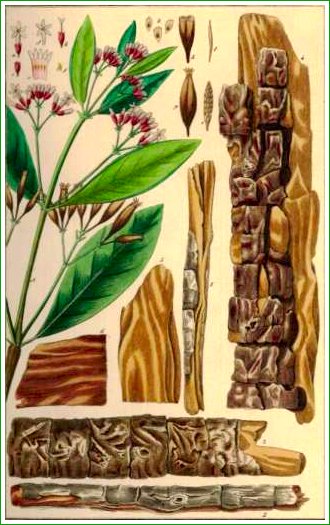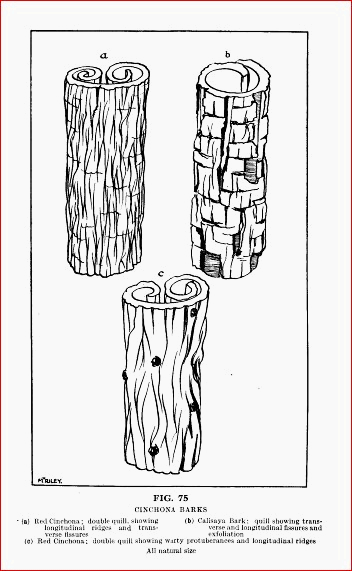
 Cinchona.
Cinchona.
Martindale�s 24th.
Compiled and Edited by Ivor Hughes.
Cinchona (B.P.C.). Cinchona Bark; Jesuit's Bark; Peruvian Bark; China;
Cortex; Quinquinas; Quina.
Dose: 0.3 to 1 g. (5 to 15 grains).
Consists of the dried bark of cultivated trees of Cinchona calisaya, C. ledgeriana, C. officinalis, and C. succirubra (Rubiaceae), or of hybrids of these containing not less than 6% of total alkaloids. Preparations are incompatible with salicylates and iodides. Foreign Pharmacopoeias: In all Pharmacopeias examined except Chin, and U.S. They specify one (C. succirubra) or more of the above species.
The principal dried barks used for the production of the salts of the cinchona alkaloids are: red cinchona bark, from C. succirubra, yielding 6 to 9% of total alkaloids, 1.5 to 3.5% being quinine; yellow cinchona bark, from C. calisaya, yielding 6 to 7% of alkaloids, 3 to 4% being quinine; pale cinchona bark (crown or Loxa bark), from C. officinalis, yielding about 6% of alkaloids half being quinine; ledger bark, from C. ledgeriana, yielding 10 to 14% of quinine. Hybrid bark, usually a hybrid between C. ledgeriana and C. succirubra, forms a large proportion of the bark of commerce and yields a high percentage of quinine.
QUININE.
Uses. Cinchona is a bitter stomachic and has astringent properties. It may sometimes cause vomiting and if taken over long periods may give rise to symptoms of cinchonism. To keep the alkaloids in solution, liquid preparations of cinchona are usually given in acid media but the decoction and the tinctures are prescribed with ammonium bicarbonate and in these cases Mucilage of Acacia should be added to suspend the alkaloids.Dec. Cinchon. Cone. (B.P.C. 1949). Concentrated Decoction of Cinchona.
Boil powdered cinchona 50 g. for 10 minutes with water 800 ml. in a covered
vessel. Cool, strain, and wash the contents of the strainer with water.
Evaporate the mixed decoction and washings to 65 ml., allow to cool, filter,
add glycerin 25 ml., alcohol (90%) 10 ml. and, if necessary, water to 100
ml.
Dose: 4 to 8 ml. (60 to 120 minims).
When Decoction of Cinchona is prescribed this concentrated decoction diluted
with seven times its volume of water may be dispensed.
Extract of Cinchona (B.P.C.). Ext. Cinchon.
A soft extract, prepared by percolation with alcohol (90%) and
standardised to contain 10% w/w of cinchona alkaloids. Protect from moisture
in a cool place.
Dose: 120 to 500 mg. (2 to 8 grains).
 Extrait de Quinquina Jaune (Fr. P.). Yellow Cinchona Extract.
Extrait de Quinquina Jaune (Fr. P.). Yellow Cinchona Extract.
A dry extract prepared with alcohol (60%) from C. calisaya and
containing 12% of total alkaloids.
Extrait de Quinquina Rouge (Fr. P.). Red Cinchona Extract.
A soft aqueous extract made from C. succirubra and containing 8% of total
alkaloids. Belg. P. has a similar extract with 10% of alkaloids. Several
foreign pharmacopoeias include a dry extract with 20% of total alkaloids.
Extrait de Quinquina Rouge (Fluide) (Fr. P.). Red Cinchona Liquid
Extract.
It contains 3-5% w/w of total alkaloids and is prepared by percolation
with diluted hydrochloric acid.
Liquid Extract of Cinchona (B.P.C.). Ext. Cinchon. Liq.
Contains 50% w/v of extract of cinchona, equivalent to 5% w/v of total
alkaloids, with hydrochloric acid, glycerin, alcohol, and water.
Dose: 0.3 to 1 ml. (5 to 15 minims).
Similar extracts are included in several foreign pharmacopoeias.
Inf. Cinchon. Acid. Cone. (B.P.C. 1949). Concentrated Acid Infusion of
Cinchona. Prepared by percolation of cinchona, 1 in 2.5, with alcohol
(20%) containing 12.5% v/v of dilute sulphuric acid.
Dose: 2 to 4 ml. (30 to 60 minims).
Inf. Cinchon. Acid. Rec. (B.P.C. 1949). Fresh Acid Infusion of Cinchona.
Cinchona 5 g., dilute sulphuric acid 1'55 ml., and boiling water 100 g.
Dose: 15 to 30 ml. ( � to 1 fl. oz.).
Mist. Cinchon. Acid. (N.F. 1939).
Liquid extract of cinchona 10 m., dilute phosphoric acid 10 m., glycerin
10 m., water to � fl. oz. Dose: 15 ml. ( � fl. oz.).
Mist. Cinchon. Ammon. (N.F. 1939). Liquid extract of cinchona 10 m., ammonium carbonate 3 gr., chloroform water to � fl. oz. Dose: 15 ml. ( � fl. oz.).
Tinct. Cinchon. (B.P.C. 1949). Tincture of Cinchona.
Extract of cinchona 10 ml., alcohol (70%) to 100 ml.
Dose: 2 to 4 ml. (30 to 60 minims).
Several foreign pharmacopoeias include a similar tincture, usually prepared
direct from cinchona by percolation.
Tinct. Cinchon. Co. (B.P.C. 1949, Ind. P.). Compound Tincture of
Cinchona. Prepared from extract of cinchona 5 g., dried bitter-orange
peel 5 g., Serpentary 2.5 g., cochineal 300 mg., and alcohol (70%) to 100
ml. The orange peel, serpentary, and cochineal, are macerated in the alcohol
for 7 days, the extract is dissolved in the strained liquid which is then
adjusted to volume with more alcohol, set aside for at least 48 hours, and
filtered.
Dose: 2 to 4 ml. (30 to 60 minims).
Vin de Quinquina Officinal (Fr. P.). Cinchona Wine.
Macerate cinchona 25 with dilute hydrochloric acid 2, and alcohol (60%)
75, all by wt, for 24 hours, shaking occasionally. Add red wine 920,
macerate 24 hours and filter. Fr. P. also includes cinchona wine made
from red cinchona liquid extract 3, alcohol (60%) 5, and red wine 92, all by
wt.
PROPRIETARY PREPARATIONS OF CINCHONA.
Dose: 1 to 2 teaspoonfuls with or immediately after meals.
Vibrona (Fletcher, Fletcher & Co.). A wine containing 0.03% of the total alkaloids of cinchona (as the hydrobromides).
Totaquine (B.P.). Totaquina.
Dose: 300 to 600 mg. (5 to 10 grains).
A mixture of alkaloids obtained from suitable species of Cinchona. Nearly
colourless or pale yellowish-grey, or pale brown, odourless, powder with a
bitter taste, containing not less than 70% of crystallisable cinchona
alkaloids, of which not less than one-fifth is quinine. Foreign
Pharmacopoeias: In Belg., Fr., and Mex. Also in U.S.N.F.
Mex. and U.S.N.F. specify 70 to 80% of total alkaloids and 7 to 12% of anhydrous quinine. Almost insoluble in water; soluble almost completely in warm alcohol and in chloroform; partly soluble in ether, benzene, and light petroleum. Protect from light and moisture. Uses. This mixture of cinchona alkaloids was introduced in 1934, under the auspices of the Health Organisation of the League of Nations, as a cheap and easily prepared substitute for quinine for the mass treatment of malaria.
The treatment of a large series of cases of benign and malignant tertian malaria with totaquine and with quinine showed that these two drugs were about equal in clinical value. It proved to be no more toxic and can be safely substituted for quinine with a consequent considerable saving in expenditure.�A. N. Kingsbury, Rep. Inst. med. Res., F.M.S., 1937, 4.
Ninety-five febrile malaria patients with schizonts in the blood were treated with totaquine and 132 similar patients with quinine bisulphate. In one series each patient received 15 gr. of one or other drug a day for 5 days. In a second series the daily dose of both drugs was 20 gr. The results indicated that totaquine is more effective than quinine bisulphate in similar doses in stabilising temperature, in causing the disappearance of parasites from peripheral blood and in inhibiting the formation of gametocytes in all forms of infection.�E. M. Wijerama, per Trap. Dis. Bull., 1940, 37, 668.
Cinchona Febrifuge (Ind. P.). Cinchon. Febri.
Dose: 0.6 to 1 .2 g. (10 to 20 grains).
A mixture of alkaloids from the bark of C. ledgeriana, C. succirubra and
other species of Cinchona. It contains not less than 7% of anhydrous quinine
and not less than 50% of total crystallisable cinchona alkaloids which is
the sum of the percentages of quinine, quinidine, cinchonidine and
cinchonine. It has been widely used in India as a cheap antimalarial
substitute for quinine.
Quinetum (B.P.C. 1934).
As defined by the Malaria Commission of the League of Nations in 1931,
it consists of a mixture of equal parts of quinine, cinchonidine and
cinchonine, corresponding approximately to the relative proportions of these
alkaloids in the total alkaloids of red cinchona bark. It is more constant
in composition than cinchona febrifuge.
Dose: 60 to 600 mg. (1 to 10 grains).
Did you find what you were looking for? If not use the site search engine at the top right hand of the page or consult the main library.
![]()